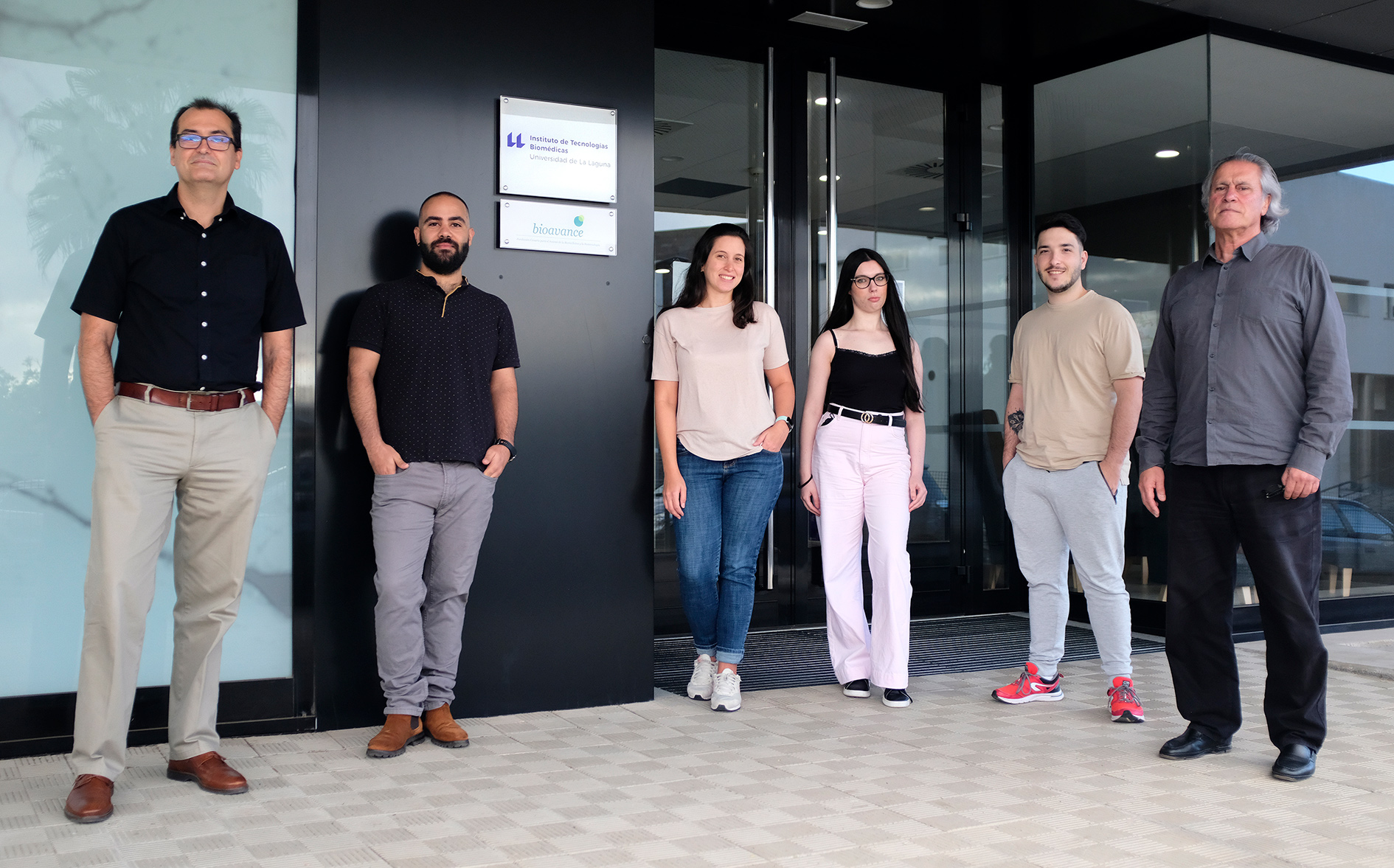Dc. Alvarez Group
Pathophysiological mechanisms of mineralocorticoid receptor action
Diego Alvarez de la Rosa is Professor of Physiology and Director of the University Institute of Biomedical Technologies (ITB) at the University of La Laguna. After receiving his PhD in Biology from the ULL in 1998, he completed a postdoctoral stay in the Department of Cellular and Molecular Physiology at Yale University School of Medicine (New Haven, CT, USA), subsequently establishing his research group at the ULL after obtaining a Ramón y Cajal contract in 2004. The research of his group focuses on elucidating the pathophysiological implications of the hormone aldosterone and its signaling mechanisms through the mineralocorticoid receptor (MR), as well as the functional study of target genes of this receptor.
About Us
- Diego Alvarez de la Rosa (coordinador del grupo): Catedrático de Universidad
- Guadalberto Hernández Hernández: Catedrático de Universidad
- Brian Almeida Prieto: estudiante de doctorado
- Arianna Vastola Mascolo: estudiante de doctorado
- Zuleima Ramos Hernández: estudiante de máster
- Julián Weller Pérez: estudiante de máster

What Do We Research?
Aldosterone is a steroid hormone produced in the cortex of the adrenal gland. It allows us to adapt to prolonged water deprivation or to plasma sodium and potassium concentration imbalances. Aldosterone plays a fundamental role in the regulation of blood pressure and mineral homeostasis, also participating in the control of acid-base balance. More recently, it has been proposed that inadequate control of aldosterone production is involved in cardiovascular and metabolic dysfunction, and alterations in the functioning of stress response systems in the central nervous system, all independently of its effects on blood pressure. Consequently, there is a growing interest in the use of aldosterone antagonists. In addition to the traditional use of these drugs as diuretics and antihypertensives, they currently have an important role in the treatment of heart failure. Other approved indications include treatment of diabetic chronic kidney disease. Additional uses of aldosterone antagonists currently under study include applications in dermatology and ophthalmology, treatment of depression and other psychiatric diseases, treatment of non-diabetic chronic kidney disease, and broader applications in conditions of the cardiovascular system.
Aldosterone exerts its physiological effects via the mineralocorticoid receptor (MR), a nuclear receptor of the steroid receptor subfamily. This receptor also displays high affinity for glucocorticoids, a group of hormones produced in the adrenal cortex with well-known immunomodulatory and metabolic functions. Therefore, MR plays a more general role in corticosteroid signal transduction, fbroadening its interest as a pharmacological target in the treatment of metabolic, cardiovascular and renal disorders, among others. The promiscuity in ligand binding to MR, as well as the recognition of DNA target sequences equal to those recognized by the glucocorticoid receptor (GR), underly an important functional overlap between both receptors, which can also interact physically. Studying the relative role of MR and GR in corticosteroid signaling is therefore essential for the development of new pharmacological interventions, as well as constituting an interesting model for the study of cross-regulation between steroid hormones, a phenomenon whose importance is increasingly appreciated.
Recently, our group has shown that transcriptional regulation by aldosterone through MR is critically dependent on direct interaction with GR. In addition, we have challenged the most widely accepted model of function to explain MR function, which is primarily based on homodimer formation. Our recent work demonstrates that MR forms higher order multimers upon binding to hormone and specific DNA sequences, forming a quaternary structure that differs from GR and other steroid receptors. Despite their differences in quaternary structure and dimerization determinant functionality, we have further shown that GR is incorporated into GR/MR heterocomplexes. This suggests that modulation of the quaternary structure may be an important target mechanism to consider for the development of selective modulators of corticosteroid signaling. Additional work by our group and others clearly indicates that the actions of MR are modified by sex, probably in part through interactions with other receptors in the oxo-steroid receptor subfamily of nuclear receptor receptors (NR3C), which includes progesterone and androgen receptors (PR and AR), in addition to MR and GR. The quaternary structure of these complexes, the molecular mechanisms involved and, more importantly, the physiological and pathophysiological outcomes of such interactions, remain poorly studied. Our current work is based on the hypothesis that MR function is decisively modulated by physical interaction with other steroid receptors, which in turn is key to explaining cell type- and sex-specific actions of the receptor.
Publications
-
Grossmann C, Almeida-Prieto B, Nolze A, Alvarez de la Rosa D.British Journal of Pharmacology, 179(13):3103–3118, 2022.
-
Sierra-Ramos C, Velázquez-García S, Keskus AG, Vastola-Mascolo A, Rodríguez-Rodríguez A.E., Luis-Lima S, Hernández G, Navarro-Gonzalez JF, Porrini E, Konu O, Alvarez de la Rosa D.American Journal of Physiology – Renal Physiology, 320(4):F628-F643, 2021.
-
Ibarrola J, Garcia-Peña A, Matilla L, Bonnard B, Sádaba R, Arrieta V, Alvarez V, Fernández-Celis A, Gainza A, Navarro A, Alvarez de la Rosa D, Rossignol P, Jaisser F, López-Andrés N.Circulation Research, 127(3):e80-e93, 2020.
-
Knoepp F, Ashley Z, Barth D, Baldin J-P, Jennings M, Kazantseva M, Saw E-L, Katare R, Alvarez de la Rosa D, Weissmann N, Fronius M.Proc Natl Acad Sci USA, 117(1):717-726, 2020.
-
Sierra-Ramos C, Velázquez-García S, Hernández G, Faresse N, Alvarez de la Rosa DJournal of Endocrinology, 244(1):149-162, 2020.
-
Cazaña-Pérez V, Cidad P, Donate-Correa J, Martín-Núñez E, López-López J, Pérez-García MT, Giraldez T, Navarro-Gonzalez JF, Alvarez de la Rosa DFrontiers in Physiology, 9:89, 2018.
-
Jiménez-Canino R, Lorenzo-Díaz F, Odermatt A, Bailey MA, Livingstone DE, Jaisser F, Farman N, Alvarez de la Rosa DEndocrinology, 158(11):4047-4063, 2017.
-
Fadel F, André-Grégoire G, Gravez B, Bauvois B, Bouchet S, Sierra-Ramos C, Polito A, Mansart A, Alvarez de la Rosa D, Annane D, Jaisser F.Critical Care Medicine, 45(9):e954-e962, 2017.
-
Jiménez-Canino R, Fernandes MX, Alvarez de la Rosa DJournal of Biological Chemistry, 291(36):19068-78, 2016.
-
Jimenez-Canino R, Lorenzo-Diaz F, Jaisser F, Farman N, Giraldez T, Alvarez de la Rosa DEndocrinology, 157(6):2515-32, 2016.
